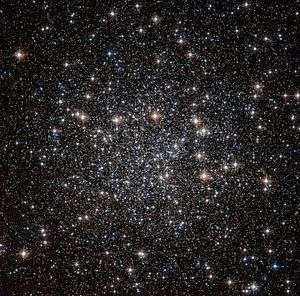NGC 4833
| NGC 4833 | |
|---|---|
|
| |
| Observation data (J2000 epoch) | |
| Class | VIII[2] |
| Constellation | Musca |
| Right ascension | 12h 59m 33.92s[3] |
| Declination | –70° 52′ 35.4″[3] |
| Distance | 21.5 kly (6.6 kpc)[4] |
| Apparent magnitude (V) | +7.79[5] |
| Apparent dimensions (V) | 13′.5 |
| Physical characteristics | |
| Mass | 4.10×105[4] M☉ |
| Radius | 42 ly[6] |
| Metallicity | = –1.71[7] dex |
| Estimated age | 12.54 Gyr[7] |
| Other designations |
GCl 21,[5] Lacaille I.4 Dunlop 164, Bennett 56 |
NGC 4833 (also known as Caldwell 105) is a globular cluster discovered by Abbe Lacaille during his 1751-1752 journey to South Africa, and catalogued in 1755. It was subsequently observed and catalogued by James Dunlop and Sir John Herschel whose instruments could resolve it into individual stars.
The globular cluster is situated in the very southerly constellation Musca at a distance of 21,200 light years from Earth. It is partially obscured by a dusty region of the galactic plane. After corrections for the reddening by dust, evidence was obtained that it is in the order of 2 billion years older than globular clusters M5 or M92.
Gallery
 NGC 4833 by Hubble Space Telescope; 3.5′ view
NGC 4833 by Hubble Space Telescope; 3.5′ view
See also
References
- ↑ "A sky full of stars". www.spacetelescope.org. Retrieved 1 August 2016.
- ↑ Shapley, Harlow; Sawyer, Helen B. (August 1927), "A Classification of Globular Clusters", Harvard College Observatory Bulletin (849): 11–14, Bibcode:1927BHarO.849...11S.
- 1 2 Goldsbury, Ryan; et al. (December 2010), "The ACS Survey of Galactic Globular Clusters. X. New Determinations of Centers for 65 Clusters", The Astronomical Journal, 140 (6): 1830–1837, Bibcode:2010AJ....140.1830G, arXiv:1008.2755
 , doi:10.1088/0004-6256/140/6/1830.
, doi:10.1088/0004-6256/140/6/1830. - 1 2 Boyles, J.; et al. (November 2011), "Young Radio Pulsars in Galactic Globular Clusters", The Astrophysical Journal, 742 (1): 51, Bibcode:2011ApJ...742...51B, arXiv:1108.4402
 , doi:10.1088/0004-637X/742/1/51.
, doi:10.1088/0004-637X/742/1/51. - 1 2 "SIMBAD Astronomical Object Database". Results for NGC 4833. Retrieved 2006-11-17.
- ↑ distance × tan( diameter_angle / 2 ) = 42 ly. radius
- 1 2 Forbes, Duncan A.; Bridges, Terry (May 2010), "Accreted versus in situ Milky Way globular clusters", Monthly Notices of the Royal Astronomical Society, 404 (3): 1203–1214, Bibcode:2010MNRAS.404.1203F, arXiv:1001.4289
 , doi:10.1111/j.1365-2966.2010.16373.x.
, doi:10.1111/j.1365-2966.2010.16373.x.
- CCD Photometry of the Globular Cluster NGC 4833 and Extinction Near the Galactic Plane, Melbourne et al., 25 September 2000, Astrophysical Journal
External links
- Basic information and data
- Photographed by the Antilhue amateur astronomical observatory
- Photometry applied to NGC 4833
- Position relative to nearby cluster NGC 4372
- NGC 4833 on WikiSky: DSS2, SDSS, GALEX, IRAS, Hydrogen α, X-Ray, Astrophoto, Sky Map, Articles and images
Coordinates: ![]() 12h 59m 34.98s, −70° 52′ 28.6″
12h 59m 34.98s, −70° 52′ 28.6″
This article is issued from
Wikipedia.
The text is licensed under Creative Commons - Attribution - Sharealike.
Additional terms may apply for the media files.
